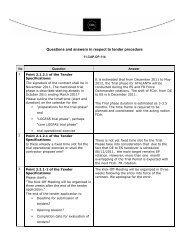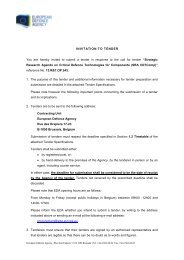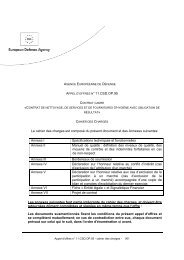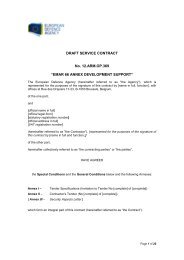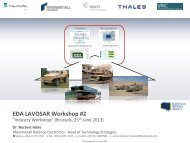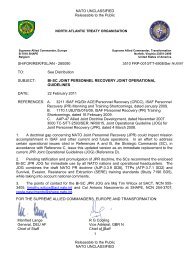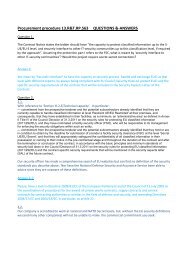capability development plan - European Defence Agency - Europa
capability development plan - European Defence Agency - Europa
capability development plan - European Defence Agency - Europa
Create successful ePaper yourself
Turn your PDF publications into a flip-book with our unique Google optimized e-Paper software.
58<br />
THREATS AND CHALLENGES DERIVING FROM<br />
POTENTIAL ADVERSARIES<br />
CATEGORY 1<br />
A Category 1 state is considered to be at the forefront of military technology, industry and equipment.<br />
The following points define a Category 1 state:<br />
• Advanced industrial economy enabling procurement and replacement of antiquated technology if<br />
required;<br />
• Advanced industrial presence, particularly on the high technology and electronic end of industry;<br />
ability to manufacture and produce advanced, next-generation military equipment and systems;<br />
• Well equipped with modern equipment and participating in advanced, ongoing projects such as nextgeneration<br />
platforms (F-35 for example);<br />
• Has evolved beyond C2 and C3 into at least an early C4I environment, and is actively involved in<br />
developing its Network Enabled Capacity and other advanced force multipliers;<br />
• Fully professional military force, or in the process of moving towards one;<br />
• High levels of training and technical aptitude among personnel, reflecting an ability to make the most<br />
efficient use of advanced systems procured;<br />
• Well established Maintenance, Repair and Overhaul procedures ensuring platforms and systems inuse<br />
function up to and beyond their intended service life without significant loss in effectiveness.<br />
1st International HELO Mountain Exercise<br />
Gap-Tallard 2009 © EDA<br />
Specifically, such adversaries may develop new and enhanced capabilities, for example:<br />
• Qualitative improvements for ground forces are envisaged including the upgrade of existing MBTs by<br />
the installation of active protection systems – a feature that could increase the usefulness of MBTs in<br />
conventional and insurgency operations;<br />
• They may procure heavy AFV with, for example V-shaped hull and sufficient armour to protect troops<br />
against RPGs and ATGW, and with active defence systems. But as a whole, these initiatives may not<br />
create new capabilities but rather increase and complement current capabilities.<br />
• Battalions (armoured and infantry) will receive organic UAVs primarily for a tactical role. The<br />
usefulness of such equipment is its complete mobility and ability to be mounted on a light vehicle or<br />
similar platform, enabling direct control by units rather than<br />
by rear-echelon controllers. With a wide range of electro-optic equipment it can provide rapid<br />
deployment ISR <strong>capability</strong> to units on demand and is ideal for deployment in complicated and cluttered<br />
environments.<br />
• High Altitude Long Endurance (HALE) and Medium Altitude Long Endurance (MALE) platforms will be<br />
introduced for use as communication and ISTAR relays to enhance coordination.<br />
• UCAVs may be introduced in the next 15-20 years, although there may be greater concentration upon<br />
the ISTAR abilities of UAVs rather than the combat <strong>capability</strong>. Advanced adversaries are not expected<br />
to field UCAVs until appropriate advances have been made in the <strong>development</strong> of autonomous flight<br />
and operation. This is not expected until early-2020s.<br />
• The success of the attack helos in the recent insurgency operations has convinced countries to<br />
procure or upgrade attack helicopters, which includes the installation of surveillance and target<br />
acquisition radar systems to concentrate on their primary task in anti-armour and to support infantry<br />
operations, including in urban environments.<br />
• Procurements will likely focus on the upgrade of its existing fleets until the entry into service of the 5th<br />
generation aircraft (F-35). This will include life extensions, fitting of advanced electronic systems,<br />
including Advanced Electronically Scanned Array (AESA) radar and a number of advanced weapons<br />
and bombs.<br />
• Significant <strong>capability</strong> boosts may be encouraged in areas of airborne SIGINT and AEW, as well as<br />
improving missile defence capabilities to protect against rockets attacks etc.<br />
FUTURE TRENDS FROM THE CAPABILITY DEVELOPMENT PLAN




